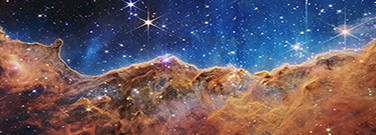James Webb Space Telescope Captures Farthest Reaches of Space

By Tom Wright
The James Webb Space Telescope (JWST) made a splash across the internet in July as the National Aeronautics and Space Administration (NASA) released its first images. Every social media outlet was awash with pictures of distant galaxies and nebulae clusters. With the evolution of special effects in science fiction movies and television, it’s easy to miss the significance of these images. The importance becomes a little clearer when you realize that you’re seeing actual images rather than an artistic interpretation of deep space.
Upholding a Legacy
James Webb, for whom the telescope was named, was the administrator of NASA from 1961 to 1968, the era known as the golden age of space exploration. It was the era of the Mercury, Gemini, and Apollo programs, the last of which succeeded in preparing and landing the first humans on the moon.
JWST was first conceptualized in 1996 and, after a series of design changes and revisions, completed in 2016. It went through testing for the next five years and finally launched on December 25, 2021.
Viewing Space in Stunning Detail
The resolution of the JWST dwarfs the Hubble telescope in terms of detail and definition and is described as 100 times more powerful. But what truly makes the JWST so special is its ability to detect near-infrared and mid-infrared wavelengths. On the electromagnetic spectrum, infrared light is beyond the visible range. It passes through areas of dense gas and dust with little to no diffraction, meaning it can be detected accurately at longer distances. The JWST detects this infrared light effectively as different shades of gray, which are then converted to color. It's so precise that it can detect over 65,000 shades of gray.
One of the downsides of this accuracy is that heat released from the telescope itself can distort the images coming in. To account for this, the JWST must operate at a very low temperature, an astonishing 6.4 kelvins, or -273 degrees Celsius.
Spurring New Discoveries
This level of detection allows the JWST to look farther back in time than the Hubble telescope. Some of the tiny dots of light in the recently released images represent what galaxies looked like 13 billion years ago. The telescope can also measure the elemental composition of those galaxies, and scientists are already reporting new discoveries based on these images.
NASA Administrator Bill Nelson said, “These images, including the deepest infrared view of our universe that has ever been taken, show us how Webb will help to uncover the answers to questions we don’t even yet know to ask; questions that will help us better understand our universe and humanity’s place within it.”
Photos courtesy of NASA.
Discussion Questions
- Why do scientists want to know more about distant galaxies? How will this knowledge help us understand our own galaxy better?
- Think of other applications for the JWST besides looking at old galaxies. What else can scientists accomplish with such a powerful telescope?

